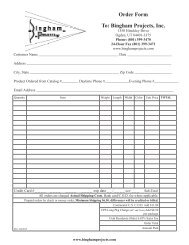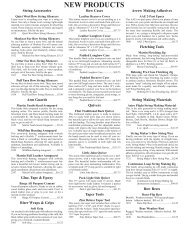current catalog pdf - Bingham Projects
current catalog pdf - Bingham Projects
current catalog pdf - Bingham Projects
Create successful ePaper yourself
Turn your PDF publications into a flip-book with our unique Google optimized e-Paper software.
Helpful Hints for the Novice Bow Builder (FAQ)<br />
It is a very gratifying experience to<br />
build your own traditional bow,<br />
and then to shoot that same bow with<br />
predictable accuracy. It is my hope<br />
that each of you will become a successful<br />
bowyer and archer. There are a few false<br />
notions and some common problems<br />
in building bows which new bowyers<br />
should be cautioned against. After more<br />
than fifty-two years in the archery business,<br />
either building or teaching others to<br />
build bows, I have been asked thousands<br />
of questions about bows and related<br />
items. I have compiled the answers to<br />
these questions in an attempt to prevent<br />
problems that might frustrate a novice<br />
bowyer.<br />
I am concerned that I might not fully<br />
understand the whole bow making<br />
process. How do I get started?<br />
The first concern is the most important.<br />
Watch the video and read the instructional<br />
materials carefully, plan your procedures<br />
in detail, and make a dry-run with all<br />
materials and equipment you will need.<br />
If, after carefully doing these things, you<br />
still have questions, please feel free to<br />
call us before beginning your project.<br />
How Should I choose my Bow Draw<br />
Weight?<br />
Make archery fun. Choose a bow draw<br />
weight that is comfortable, less than what<br />
you are capable of pulling. Many new archers<br />
become discouraged and quickly<br />
lose interest in the sport when the bow is<br />
so heavy that it is not fun to shoot, or when<br />
the bow is so heavy that accuracy is lost.<br />
Most states have a legal weight of 40-50<br />
lbs. for big game. On a cold fall day when<br />
you are stalking a buck, a lighter bow is<br />
a joy to shoot. The secret to success is in<br />
accuracy, not in muscle. In target practice<br />
or tournament shooting, an even lighter<br />
draw weight may be more desirable. A<br />
heavier bow can be considered once you<br />
have practiced, muscles are firming up<br />
and you are getting a feel for archery.<br />
Bow Design<br />
It is of great concern to me that some<br />
prospective first-time bowyers want to<br />
revolutionize archery design. It seems<br />
to be human nature to feel that your own<br />
design will bring about superior<br />
performance and artistic design<br />
immediately. Personal pride in one’s<br />
own handiwork is notable, but remember<br />
that experimentation is usually a slow,<br />
painful, and often expensive process.<br />
Sometimes a change in recurve design<br />
can cause limb twist, weight change, and a<br />
lessening in performance. You will notice<br />
that, in a general sense, the limb design<br />
is very similar throughout the archery<br />
industry. Often bows from various<br />
manufacturers will appear different<br />
because the riser section (handle) may<br />
vary in design, shape or color of material.<br />
How do I get rid of hand shock?<br />
I am asked repeatedly about hand shock.<br />
You often notice this when shooting a<br />
longbow for the first time. After you have<br />
shot for a while, you will become less<br />
aware of this when you release the arrow.<br />
You are less likely to notice this when<br />
shooting a recurve, take-down recurve or<br />
even a take-down longbow. It is a simple<br />
law of physics, relating to weight and<br />
mass. The flat longbow has a heavy, long<br />
limb and a short, light riser. The motion of<br />
the long limb cannot be absorbed by the<br />
smaller riser, thus the hand shock. When<br />
compared to the longbow, the recurve and<br />
take-down recurve limb is shorter and<br />
lighter with a larger and heavier riser; the<br />
shock of the lighter limb moving forward<br />
is absorbed by the riser, thus lessening the<br />
hand shock and giving the “soft feel”.<br />
What is “stacking”?<br />
“Stacking” is a term which also bothers<br />
novices. This is the amount of increase<br />
in weight as the bow is drawn. It occurs<br />
in all bows, but can be intensified in three<br />
ways. First, the bow may be too short<br />
for the draw length. A longer bow could<br />
help this problem. Second, the ratio of<br />
fiberglass weight or thickness should also<br />
be increased. Third, the more radical, or<br />
pronounced, the limb design, the more the<br />
stack will increase. The use of multiple<br />
tapers in a limb can also cause stacking.<br />
Which bow limb laminations should I<br />
choose?<br />
For many centuries bows were made<br />
from a solid piece of wood such as yew<br />
or osage. The bows were household tools<br />
used to hunt food and as protection from<br />
enemies. Most of these were longbows.<br />
Later, recurve styles were laminated with<br />
strips of sinew or horn for more efficiency.<br />
Now we have high-tech materials which<br />
have revolutionized the archery world,<br />
both in efficiency and design.<br />
Compound bows are usually built<br />
from solid fiberglass limbs because<br />
of the great stress in the limb design.<br />
Traditional bows, however, are built<br />
from outer layers of glass laminate over<br />
wood cores. The vast majority of today’s<br />
bowyers use a core wood or cane laminate<br />
combined with an outer layer of Bo-Tuff<br />
Glass. Bow draw weight is determined by<br />
the thickness of these two materials. Bow<br />
design and length also determine<br />
poundage. Careful records of micrometer<br />
readings of total limb thickness can be<br />
very helpful in determining bow weight.<br />
Weight control is a science which must<br />
be mastered by a good bowyer. Instructions<br />
from manufacturers and suppliers<br />
are also invaluable to the novice. Example:<br />
The <strong>Bingham</strong> 58” Take-Down<br />
Recurve bow will vary approximately 1<br />
lb. for every change of .001 of an inch<br />
in thickness. The <strong>Bingham</strong> longbow will<br />
change approximately 1 lb. for every<br />
change of .003 of an inch in thickness.<br />
Bow Glass laminations come in<br />
several widths, thicknesses, lengths and<br />
colors. There are a number of core woods<br />
available that can be used in bow<br />
limbs. Refer to this <strong>catalog</strong> for a<br />
list of many of the most beautiful<br />
and best performing core wood and<br />
cane laminations. These laminations<br />
can be purchased either tapered or<br />
parallel. Tapers are most commonly<br />
used in a .002 per inch taper 36” long.<br />
Some bowyers use several tapers with a<br />
.001” taper per running inch. I prefer a<br />
combination of a taper used with<br />
parallels. With this combination, you<br />
achieve excellent limb action and a fast,<br />
smooth limb.<br />
Overlays can be glued to limb tips to<br />
furnish additional strength and color.<br />
Core laminations may be dyed to add<br />
variety under clear glass. Always use a<br />
water or alcohol based dye.<br />
Which riser should I choose?<br />
With traditional bows (Recurves, Take-<br />
Down Recurves, Longbows and Take-<br />
Down Longbows), riser (handle) woods<br />
are chosen for color, beauty of grain,<br />
strength and ability to take a good finish.<br />
Avoid soft woods as they cannot<br />
stand the stress of a working bow. Avoid<br />
those woods with an open grain structure,<br />
those that will “bleed” color, or<br />
those whose oily nature prohibits a good<br />
finish.<br />
With the advanced technology of high<br />
stressed limbs found in compound bows<br />
came multi-lamination risers made from<br />
blocks of 1/16” veneer. These laminated<br />
risers are very strong and are available<br />
in many colors. Another way to achieve<br />
a colorful riser is to laminate combinations<br />
of accent strips made of hardwood,<br />
phenolic or core-tuff. This will furnish<br />
strength and beauty.<br />
What is the difference between UL<br />
and ULS glass?<br />
ULS has a 50/50 woven fiberglass inlay<br />
(scrim) that provides cross strength (90<br />
degrees to the longitudinal axis). This<br />
scrim layer will give strength lengthwise<br />
to help reduce longitudinal cracking.<br />
For most designs, however, UL and<br />
ULS work equally well.<br />
<strong>Bingham</strong> <strong>Projects</strong><br />
801.399.3470 Fax: 801.399.3471<br />
-27-<br />
www.binghamprojects.com





